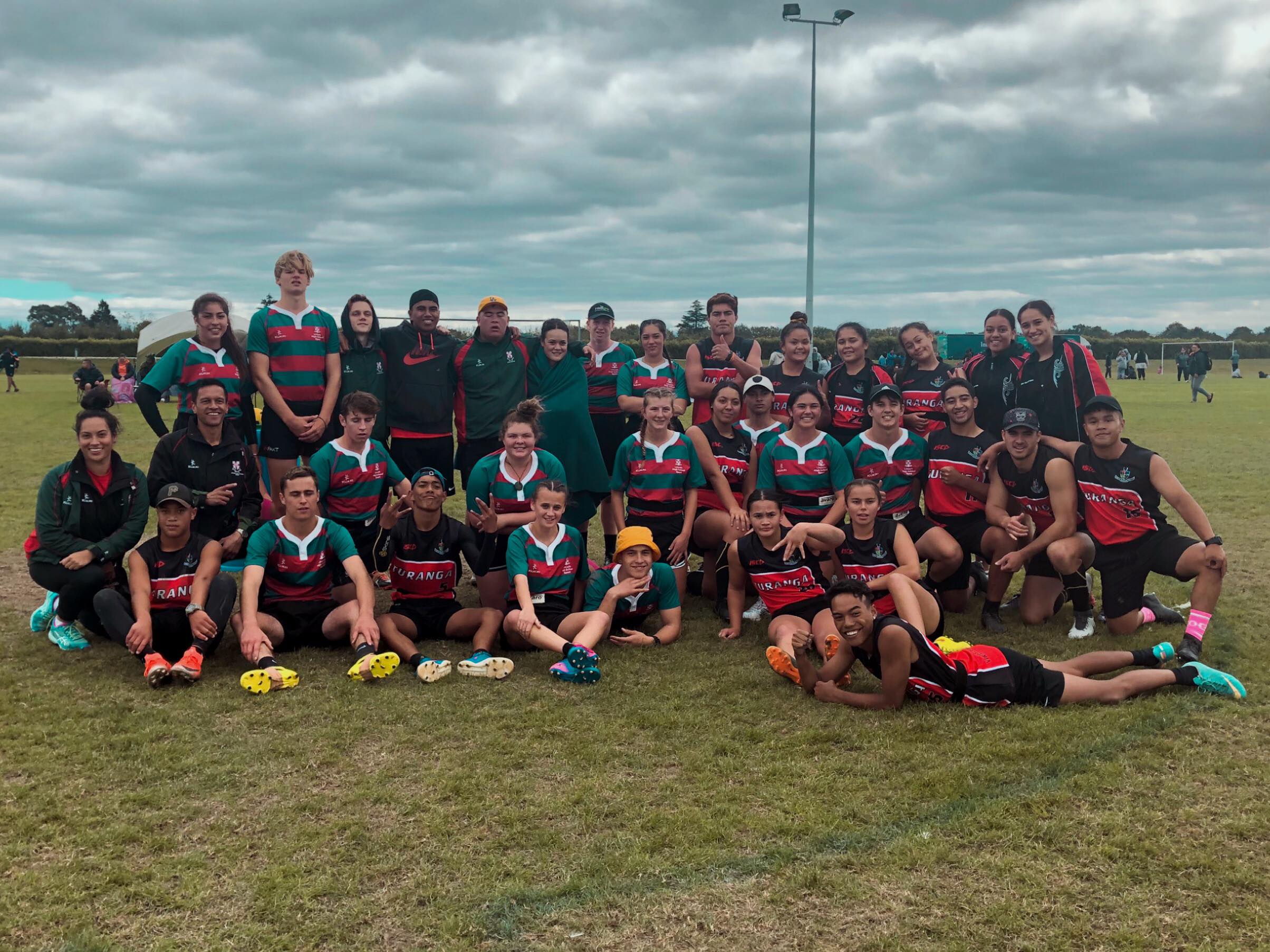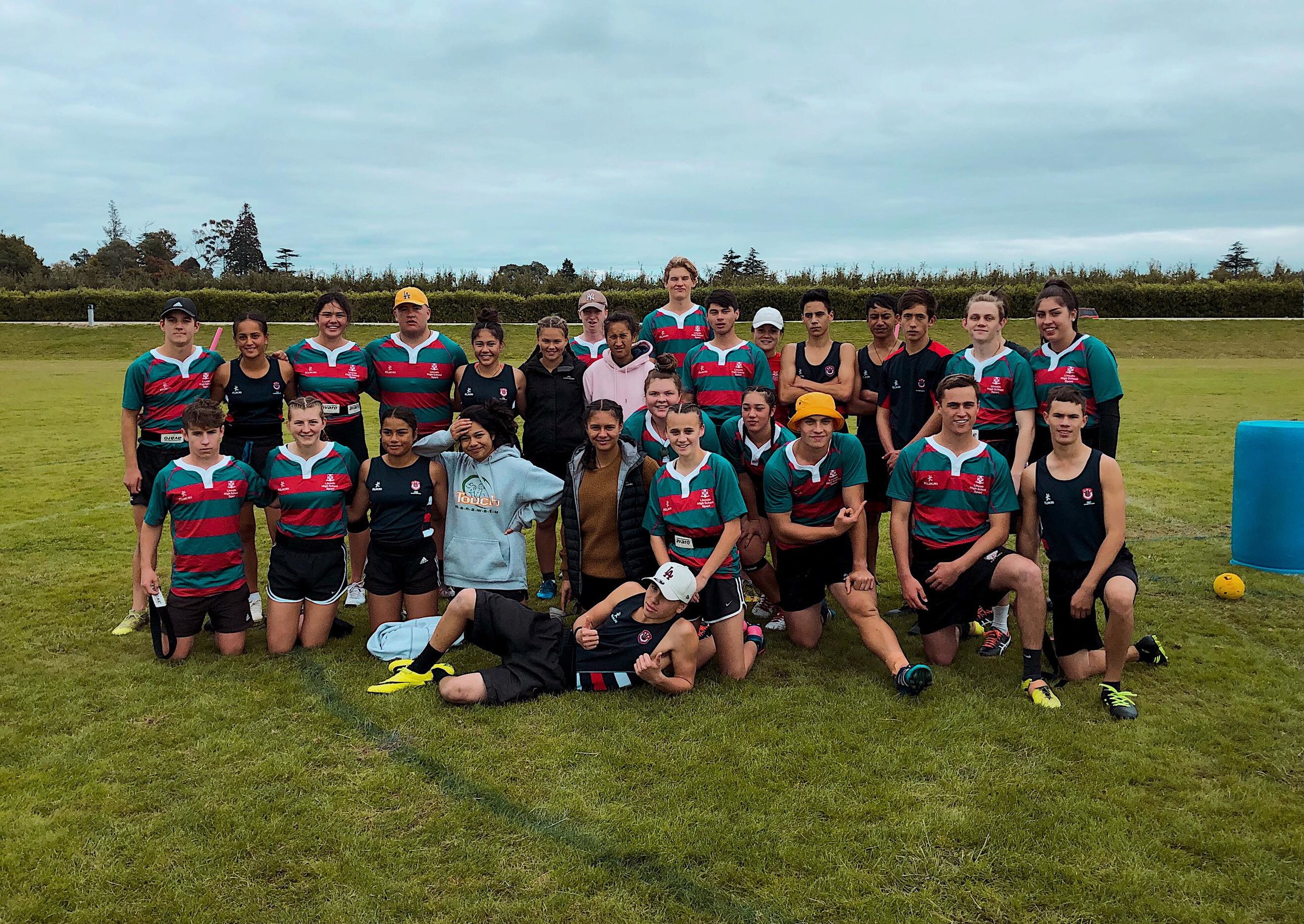Interview with Tihirangi Brightwell - Lincoln High School
Interview with Tihirangi Brightwell - Lincoln High School
At the New Zealand Secondary School Ki o Rahi Nationals we were fortunate enough to meet Ki o Rahi enthusiast Tihirangi Brightwell who brought along his team from Waitaha, Lincoln High School.
2019 NZSS Ki o Rahi Nationals - Lincoln High School Winners of Ki o Rahi Spirit Trophy
We wanted to find out a little bit more about Tihirangi and his love for the game of Ki o Rahi as well as to gain some insight into Ki o Rahi in Waitaha!
Thank you Tihirangi and Lincoln High School for a small insight into your world of Ki o Rahi!
I te taha o tōku māmā ko Taranaki, ko Muaūpoko, ko Ngāti Kahungunu ngā iwi
I te taha o tōku pāpā ko Ngāti Porou te iwi.
I tipu ake au ki Opunake, Taranaki. Engari, kei Rolleston, Waitaha, tōku kāinga ināianei, ki te
taha o taku hoa rangatira, me āku tama e rua.
He kaiako reo Māori, he kaiako kapahaka hoki ahau ki Te Kura Tuarua o Waihora (Lincoln High
School).
Ko Tihirangi Brightwell tōku ingoa.
1. How did you get into Ki o Rahi?
I began my teaching career at Aranui High School (now Haeata) on the eastside of Christchurch
in 2013, and it was there that I was introduced to the kēmu Kī-o-Rahi. The team needed a
teacher to supervise them at a tournament, and as I knew nothing about it I wanted to have a
look. I often wish Kī-o-Rahi was around when I was in high school!
2019 NZSS Ki o Rahi Nationals - Lincoln High & Turanga Wahine Turanga Tane
2. How many years have you been coaching Lincoln and what are the biggest things you’ve learned
as a coach?
I began teaching at Lincoln High School, Lincoln is a small town out of Christchurch, in term 3 of
2015, and almost immediately started teaching my reo Māori classes Kī-o-Rahi. Some students
had heard of it or played it, but the majority of students had never played it, or had never played
it competitively before. The biggest thing I’ve learnt as a coach (there are many things, and I still
have much to learn) is that I still have a long way to go as a coach! Setting up trainings, coming
up with drills, picking squads, managing players on competition day, understanding the field and
how to position taniwha and kīoma, they’re all facets I need to develop.
3. What do you enjoy about Ki o Rahi?
It’s hard to describe why I have such a passion for this kēmu, but I do, and the rangatahi do as
well. I enjoy the fact that Kī-o-Rahi is a sport that utilizes people of all different shapes, sizes and
abilities. I enjoy Kī-o-Rahi as it draws on facets and strategies from a whole range of sports; you
have the evasion of touch, throwing and blocking of handball, isolations like in basketball, etc. I
enjoy Kī-o-Rahi as it has been a way for non-Māori to engage with kaupapa Māori, and in te ao
Māori.
4. Why did you decide to bring Lincoln to Ki o Rahi Nationals?
Again, a whole host of reasons. I wanted those students who had played Kī-o-Rahi with me since
Yr 9 to have a chance to compete at a national level before they depart this year, now as Yr 13s. I
wanted the team to see how strong Kī-o-Rahi is in NZ, and how celebrated it is. I wanted to test
ourselves against quality opposition, and to show to ourselves and the other regions that we do
belong there. We see other school sport teams competing at national level yearly, so why not Kī-
o-Rahi?
5. What did preparation look like for Lincoln in the lead up to Nationals?
For the majority of term one we would practice once a week. The regional competition down
here in Waitaha, Canterbury, is a two-touch module, not ripper, so we also needed to become as
familiar with the ripper style of competition as possible. We also had our first regional
tournament on April the 5 th , the week prior to the nationals, which was also handy for
preparation.
2019 NZSS Ki o Rahi Nationals - Lincoln High & Te Kuiti
6. Going into Nationals in Hastings, what were you hoping to get out of it? What were your fears?
I don’t know if we were exactly fearful, but there was a huge unknown in terms of the
opposition, the officiating, etc. What I wanted most of all was for the team to play hard
regardless of who the opposition was, and to show the rest of Aotearoa that we love this game,
and that we’re not all that bad at playing it either. It’s also about validation for us as a team, but
also for Kī-o-Rahi as a sport.
7. What other sports do the team play? And how does that contribute to the team?
Some of the sports members of the team play are touch, league, basketball, rugby, volleyball,
netball, and football. If they are in the top school teams for their sport it certainly contributes to
fitness. With touch experience I find it helps with the draw and pass, and working for overlaps.
Basketball and volleyball I find helps with jump shots when we’re taniwha, and also being
familiar with a round ball. Netball is useful when playing man on man defense, as it’s about
keeping close to your opponent and being careful not to lose them. Not that I’m an expert on any
sport, but you can’t help but notice the relationship between the sports.
2019 NZSS Ki o Rahi Nationals - Lincoln High & Fielding High School
8. What were the main things you gained from the experience of Nationals?
I certainly saw that, if we want to compete for that top position, we need to ascend a level as
players, and for myself as a coach in terms of fundamental skills, but possibly more importantly
in terms of offensive and defensive strategy when taniwha or kīoma. The mountain to climb isn’t
insurmountable, but without a doubt we need to find a way to make up ground, and quickly, as
teams will also continue to improve. I also saw that the other teams weren’t all that different
from my own team; just rangatahi who play for the love of it.
2019 NZSS Ki o Rahi Nationals - Lincoln High & Tarawera High School
9. What has been the highlight of your Ki o Rahi journey so far?
Getting the Lincoln High School team to the nationals was really important to me, for a number
of reasons, however this would be the only national secondary schools competition that a
number of my students will have attended during their time at high school. But taking home the
Kī-o-Rahi Spirit Trophy was such a good feeling for myself and the team. Competing for the first
time and being recognized by the kaiwawao as a team that was deserved of the Spirit of Kī-o-
Rahi Trophy was a really positive and uplifting experience for the whole team.
10. Who are the teams you enjoy playing against and why?
We want to play the best teams, as I believe that that is where the most growth and
development for us will happen. Te Kuiti High School beat us 11-9 in pool play, which meant they
finished top of the pool, and it was a good game that taught me as a coach the power of a
suffocating taniwha defense. Also competing against Tūranga Boys and Girls High Schools was
important as I remember reading that they were considered one of the strong Kī-o-Rahi teams of
Aotearoa. In that game I believe we were down 13-3 at halftime, then our taniwha did an
amazing job bringing the scores to 13-10 at the end of the third quarter. Tūranga eventually ran
out 21-10 (I think!) winners, but I was really proud of the effort from the squad.
11. Outside of your school – how popular is Ki o Rahi in the area? What other schools are usually at
your regionals etc?
Kī-o-Rahi is growing in popularity here in Waitaha, with a 16 team competition being the norm
over the past couple of years. Those 16 teams could also be 16 different schools, though if a
team cannot make it another school would usually put in a second team. The teams that I have
seen compete regularly over the past 5 years would be ourselves (Lincoln High School), Linwood
College, Burnside High School, Te Kura Kaupapa Māori o Te Whānau Tahi, Te Kura Whakapumau
i te Reo Tuturu ki Waitaha, Cashmere High School, Riccarton High School, Te Pā o Rākaihautū,
Christchurch Boys and Girls High Schools, and a number of other kura. Kī-o-Rahi is also well into
the primary schools, last year my squad was asked to help referee a local Kī-o-Rahi competition
for our district, with about 10-12 primary schools participating.
2019 NZSS Ki o Rahi Nationals - Lincoln High & Tai Wananaga Tu Toa
12. Who are the main drivers of Ki o Rahi in your area and how have they helped make Ki o Rahi as
popular as it is?
Without a doubt I would have to mihi to the team at Ara Institute of Canterbury, for all of their
mahi in making the regionals happen every year. Within each school there are kaiako, such as
myself, who are deeply passionate about Kī-o-Rahi and for whom this sport is a high priority. One
of the most important things Ara have done is to make the sport available to us, and to create a
competition in which we can competitively play other kura and share the field with others who
love the game.
13. What visions do you/the team have for Ki o Rahi in the future?
I have visions of Kī-o-Rahi being played internationally. I have visions of Kī-o-Rahi becoming a
sport that shares the same limelight as touch or netball does. I have visions of there being a
competition in which I can play in. I have visions of Kī-o-Rahi being televised and watched by the
masses. A shorter term goal would possibly be to run a South Island tournament, as a precursor
to the national tournament. I also have visions of one day beating Rakaumangamanga or Ngā
Tapuwae in the final! One day.
2019 NZSS Ki o Rahi Nationals - Lincoln High & Te Kura o Kokohuia







